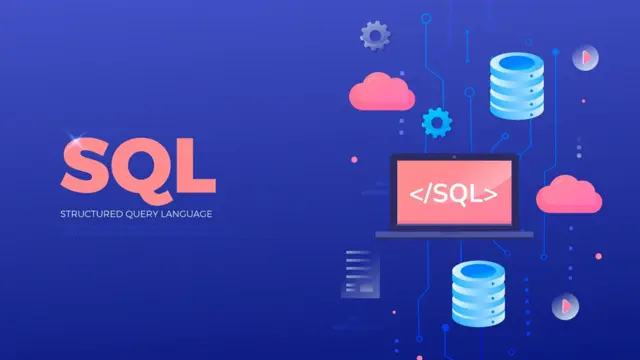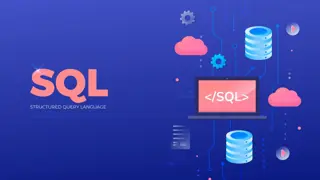
SQL Programming with Microsoft SQL Server
Self-paced videos, Lifetime access, Study material, Certification prep, Technical support, Course Completion Certificate
Uplatz
Summary
- Reed courses certificate of completion - Free
- Uplatz Certificate of Completion - Free
Add to basket or enquire
Overview
Uplatz offers complete course on SQL Programming with Microsoft SQL Server. This is video-based online course (self-paced training). You will be awarded Course Completion Certificate at the end of the course.
SQL Programming with Microsoft SQL Server involves working with the Microsoft SQL Server database management system using the SQL language. Microsoft SQL Server is a relational database management system (RDBMS) developed by Microsoft, and it is widely used for managing and querying relational databases.
Here's a description of SQL Programming with Microsoft SQL Server:
Database Management
- SQL Server enables users to create, modify, and manage relational databases. It provides tools for creating and maintaining database structures, including tables, indexes, views, and stored procedures.
Transact-SQL (T-SQL)
- Microsoft SQL Server uses Transact-SQL (T-SQL), an extension of SQL, as its programming language. T-SQL includes additional features such as procedural programming constructs, local variables, and error handling, making it a powerful language for database programming.
Stored Procedures and Functions
- SQL Server supports the creation of stored procedures and user-defined functions. These database objects allow developers to encapsulate SQL logic on the server, improving code reusability, security, and performance.
Triggers
- Triggers in SQL Server are special types of stored procedures that automatically execute in response to certain events, such as data modifications. Triggers are useful for enforcing business rules and maintaining data integrity.
Views
- Views provide a way to present a subset of data from one or more tables in a structured manner. They can simplify complex queries and restrict access to sensitive information.
Indexing and Query Optimization
- SQL Server includes features for optimizing query performance, such as the ability to create indexes on tables. Proper indexing can significantly enhance the speed of data retrieval.
Security Features [this topic is not in scope of this course]
- SQL Server provides robust security features, including user authentication, role-based access control, and encryption. Database administrators can define permissions at various levels to control access to data and database objects.
Integration Services (SSIS) [this topic is not in scope of this course]
- SQL Server Integration Services (SSIS) is a part of the SQL Server suite that enables the creation of data integration and workflow solutions. It is used for tasks such as ETL (Extract, Transform, Load) processes.
Reporting and Analysis Services (SSRS and SSAS) [this topic is not in scope of this course]
- SQL Server Reporting Services (SSRS) allows the creation, management, and delivery of reports, while SQL Server Analysis Services (SSAS) provides online analytical processing (OLAP) and data mining functionality.
Database Maintenance and Monitoring [this topic is not in scope of this course]
- SQL Server offers tools for database administrators to perform routine maintenance tasks, monitor performance, and troubleshoot issues. This includes features like SQL Server Management Studio (SSMS) and dynamic management views.
SQL Programming with Microsoft SQL Server involves leveraging these features and tools to design, implement, and maintain database solutions that meet the needs of applications and businesses. It is an essential skill for developers, database administrators, and other professionals working with SQL Server databases.
Certificates
Reed courses certificate of completion
Digital certificate - Included
Will be downloadable when all lectures have been completed
Uplatz Certificate of Completion
Digital certificate - Included
Course Completion Certificate by Uplatz
Curriculum
Course media
Description
SQL Programming with Microsoft SQL Server - Course Syllabus
- Introduction to Microsoft SQL Server
- Select and Where
- SQL Sub Languages - Order By Clauses
- Any - All - Select Into - Insert Into - Case
- Delete - Top - Aggregate Functions - Wild Cards
- Insert - Update - Is Null Commands
- In - Between - Table Alias
- SQL Comments - SQL Operators
- Joins
- Union All - Union - Group By - Having - Exists - Not Exists
- Null Functions - Transact SQL
- Examples - If - Conditional Statements
- Goto Statement - Looping Construct
- Sub Programs - Stored Procedures
- Stored Procedure Examples
- Modifying and Dropping a Stored Procedure
- Dynamic Queries - Procedure Returning Values - Functions
- Break - Continue - Exception Handling
- Structured Exception Handling
- Multiple and Nested Try Catch Blocks
- Using Anonymous Block - Table Valued Functions
- Backup DB - Differential Example - DDL Statements
- User Defined DB - Creating DB with GUI - Query - Commands
- Database Constraints and Domain Integrity Constraints
- Primary Key and Composite Key
- Creating 1-to-1 Relationship - Indexes
- Views and Types of Views
- Auto Increment - SQL Date Operations
- Hosting
Who is this course for?
Anyone who wants to make a mark in this world!
Requirements
Passion and determination to achieve your goals!
Career path
- SQL Server Developer
- SQL Programmer
- Database Engineer
- Data Engineer
- Data Analyst
- Data Scientist
- Machine Learning Engineer
- SQL BI Developer
- Reporting Analyst
- Software Developer
- Application Developer
- Database Administrator
- Data Architect
- SQL Engineer
- SQL Application Support Analyst
- BI Specialist
- SQL Analyst
- Data Transformation Analyst
- Data Modeler
- Quantitative Engineer
- Data Consultant
- MS SQL DBA
Questions and answers
Hi, how can I get a Certificate of Completion? is there an exam? thanks
Answer:Hi Magdalena There is no exam. Once you complete the course to your satisfaction, you just need to let us know post which we will issue you the Certificate of Completion within 24 hours. Indu Team Uplatz
This was helpful.Do I need to have my own license to excel 2016 or is this included in the package?
Answer:Hello Dayna You need to have your own excel. If you want full access then you should buy live tutor-led classes.
This was helpful.I am looking at taking this course, but have tried other on line courses. If I have a query, how can I get a response?
Answer:Hi Pat We will provide you answers to your technical/course related queries over email so no need to worry on that. Regards Indu Uplatz
This was helpful.
Reviews
Legal information
This course is advertised on reed.co.uk by the Course Provider, whose terms and conditions apply. Purchases are made directly from the Course Provider, and as such, content and materials are supplied by the Course Provider directly. Reed is acting as agent and not reseller in relation to this course. Reed's only responsibility is to facilitate your payment for the course. It is your responsibility to review and agree to the Course Provider's terms and conditions and satisfy yourself as to the suitability of the course you intend to purchase. Reed will not have any responsibility for the content of the course and/or associated materials.


